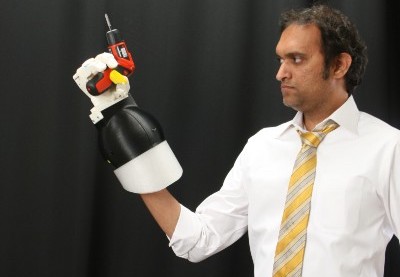
At the age of eight, Bhargav Gajjar was experimenting with an articulated wooden diver. His father made it for him after the boy became fascinated by Jules Verne’s novel Twenty Thousand Leagues Under The Sea. Water was scarce in India, so his parents allowed him to play in a half-filled water tank. “One of the hardest challenges I found was to try to make a wooden diver walk on the tank bottom,” said Gajjar. It was an early experience with the challenge of articulation.
Now Gajjar is the CEO of Vishwa Robotics in Cambridge, Mass., and has moved on from boyish tinkering to technology that will revolutionize deep-sea exploration–and perhaps much more.
The diver was just one of the young Gajjar’s many projects. He took apart a clockwork turtle to see how it worked; his parents recognized this as curiosity rather than vandalism and encouraged him by providing more toys for him to dismantle. Soon, he started building his own animal-like robots.
“I went from paper to cardboard to plastic to aluminum designs by the time I was eleven,” said Gajjar. “When NASA Sojourner landed I had already created a cockroach-inspired six-legged Mars rover in my backyard laboratory in India with crude hand-powered tools.”
The proudest moment of Gajjar’s early career came when his skill was recognized by an iconic figure in space exploration.”I got a letter from Carl Sagan applauding a spacecraft design I had imagined to explore methane oceans on Titan, which are hypothesized to harbor alien life.”
One project for the U.S. Air Force involved developing legs for small drones so they might perch on wires or branches. Gajjar spent months looking at high-speed footage of hawks and other birds to see how they do it. He produced some simple but very effective legs which can be fitted to hand-launched drones. The Air Force is now looking at applications. By perching, a drone can save battery power and keep watch for longer while remaining less conspicuous than one circling overhead.
But Gajjar is most enthusiastic about the Vishwa Extensor, a remarkable new robotic hand for deep-sea divers–because the real problem underwater is not walking, but handling things. Below a hundred meters (or about 330 feet), the pressure is so great that divers have to wear hard suits and manipulate objects using clumsy prehensors resembling giant pliers. Even the simplest task is difficult and exhausting, and it is impossible to use most tools or other human devices with prehensors.
The Vishwa Extensor is a robotic hand which mirrors the movements of the operator’s hand inside a glove within the hard suit. It also provides force feedback so the operator can grip as tightly or gently as necessary. For the first time, divers will be able to pick up delicate undersea creatures or retrieve fragile objects from sunken wrecks. They will also be enabled to use normal hand tools, operate hatches, and carry out routine maintenance tasks far more easily than with awkward prehensors. For the underwater gas and oil industry, the Vishwa Extensor promises to make work faster and safer, as well as expand the scope of operations.
Gajjar is also working on a project that will attach larger Vishwa Extensors and a video camera to unmanned submarines. An operator in a ship above will be able to touch and handle objects on the seabed without ever going underwater. The Extensors can be as large and powerful as necessary, enabling the operator to push aside boulders or bend metal plates to better access a wreck.
Looking further ahead, Gajjar foresees use of robotic hands in other hostile environments. For example, operations outside the International Space Station currently require lengthy and hazardous spacewalks. A remotely-controlled humanoid robot fitted with Vishwa Extensors could do the same job far more easily.
After successfully developing robot feet and hands, Gajjar is now working on legs. He has already done some work for the U.S. military on an exoskeleton, and wants to make a simpler version of the technology more widely available. “I’m building a pair of robotic exoskeleton legs for my elderly father,” said Gajjar. “An exoskeleton is placed outside human legs and attaches between hip and the foot.”
The idea is not to create an Iron Man-style superhero, but simply to counteract the effects of aging on leg muscles and balance. “An elderly person will have the stamina of a much younger person, will not fall accidentally, and can easily perform sit-to-stand tasks, which are very hard due to muscle atrophy.”
There will be challenges in making the technology simple and affordable enough for the mass market, but there no doubt that Gajjar has the technical expertise to give the legs life. After all, working with human-style articulated legs was where he started.

How We Get To Next was a magazine that explored the future of science, technology, and culture from 2014 to 2019. This article is part of our Design & Innovation section, which looks at new devices, concepts, and inventions that are changing our world. Click the logo to read more.

